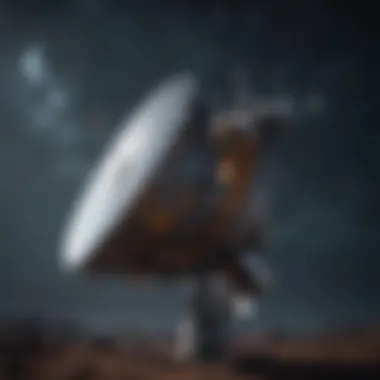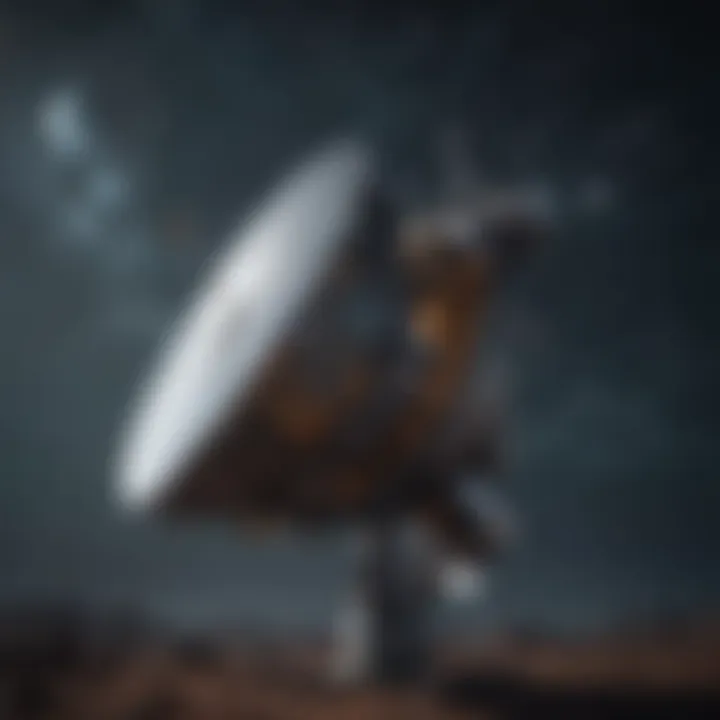Exploring Telesatellite Technology: Impacts and Innovations


Overview of Research Topic
Brief Background and Context
Telesatellite technology has undergone significant transformation since its inception. It started with simple communication satellites, evolving into complex systems providing various services including television broadcasting, internet connectivity, and global positioning systems. With thousands of satellites orbiting Earth today, the breadth of applications has expanded remarkably, making it vital to understand how these technologies operate and their implications for global communications.
Importance in Current Scientific Landscape
As our reliance on satellite-based communication increases, the role of telesatellite technology becomes more prominent. Understanding its operational principles is crucial for researchers and professionals alike. This technology influences multiple sectors, including telecommunications, weather forecasting, disaster management, and navigation. Recognizing the impact of telesatalites helps framed discussions around future innovations, regulatory challenges, and societal implications.
Methodology
Research Design and Approach
This article employs a comprehensive literature review methodology. It aims to synthesize existing research on telesatellite technology, focusing on historical developments, current applications, and future trends. By analyzing various studies, the article aims to provide nuanced insights into the technical and regulatory landscapes governing satellite operations.
Data Collection Techniques
Data for this analysis was gathered through a range of academic journals, industry reports, and governmental publications. To compile a rigorous understanding of telesatellite development, sources such as the Journal of Satellite Communications and the International Journal of Satellite Communications were referenced. The collected data includes historical trends, advancements in satellite technology, and case studies demonstrating practical applications of telesatellite services as well as their implications for society.
Understanding Telesatellite Technology
Telesatellite technology plays a crucial role in contemporary communication and data transmission systems. Grasping its foundational components is vital for students, researchers, and professionals engaged in fields like telecommunications, satellite engineering, and environmental science. This section will explore essential elements, benefits, and considerations surrounding telesatellite technology, enhancing comprehension of its broad impact.
Definition and Overview
Telesatellite technology refers to the use of satellites orbiting the Earth to facilitate communication, navigation, and data collection. These satellites are equipped with advanced equipment that allows for the transmission of signals across vast distances. A satellite in a geostationary orbit, for instance, remains fixed relative to a point on the Earth's surface, which enables consistent and reliable communication links. Areas such as broadband internet access, television broadcasting, and global navigation system services depend on this technology.
Telesatellites employ various frequencies to communicate, with microwave frequencies being the most common due to their ability to penetrate the atmosphere effectively. Their operational framework comprises ground stations, the satellites themselves, and a complex network of signal processing equipment. Together, these components create a robust communication system that supports countless applications across different sectors.
Historical Context
The evolution of telesatellite technology is marked by significant milestones that have shaped its current capabilities. The launch of Sputnik 1 by the Soviet Union in 1957 marked the onset of satellite technology. This event prompted a rush to explore various applications of satellites, leading to the deployment of Telstar in 1962, which was the first satellite to facilitate live television broadcasts.
In subsequent years, advancements in materials and technology allowed for the development of more sophisticated satellites. The Intelsat series launched in the late 1960s enhanced international telecommunications, while later innovations enabled the integration of data services.
Moreover, the advent of miniaturization and advancements in digital technology have led to lighter and more efficient satellites, capable of operating in low Earth orbit. This shift has also opened the door for small satellite ventures and constellations, such as SpaceX's Starlink, which aim to provide global internet coverage. This historical progression illustrates how far telesatellite technology has come and sets the stage for future innovations and applications.
The Architecture of Telesatellites
The architecture of telesatellites serves as a fundamental cornerstone in understanding their functionality and impact. Analyzing the design and structural components involved can give valuable insights into how these satellites operate and their role within global communication, navigation, and Earth observation frameworks. A robust architecture not only enhances performance but also addresses challenges related to efficiency and sustainability.
Components of Telesatellites
The architecture of a telesatellite integrates several key components, each contributing to its overall functionality:
- Bus: This is the main support structure that houses satellite electronics, power systems, and communication devices. It provides stability and protection against environmental factors.
- Payload: Essential for mission objectives, the payload includes transponders, antennas, and other devices that enable communication or data gathering. Its design is critical for achieving specific operational goals.
- Power Supply: Typically, solar panels collect energy from the sun, ensuring the satellite operates smoothly. Battery systems store energy for nighttime use.
- Propulsion System: This system maneuvers the satellite in orbit, making adjustments to maintain its position or perform orbital transfers.
- Thermal Control: Protecting the satellite’s sensitive components from extreme temperatures requires a well-designed thermal control system, ensuring operational stability across various conditions.
Understanding these components is vital for evaluating a satellite's mission capabilities, longevity, and operational reliability.
Satellite Orbits: Types and Implications
The choice of orbit has significant implications for satellite performance and application. There are several primary types of satellite orbits:


- Geostationary Orbit (GEO): This orbit allows satellites to maintain a constant position relative to the Earth's surface. Positioned around 35,786 kilometers above the equator, GEO is particularly advantageous for telecommunications as it allows a continuous line of sight to ground stations.
- Low Earth Orbit (LEO): Satellites in LEO orbit at altitudes ranging from 160 to 2,000 kilometers. This type provides low latency communication and is favored for Earth observation and scientific missions but requires more satellites to achieve global coverage.
- Medium Earth Orbit (MEO): Found between LEO and GEO, typically around 20,200 kilometers, MEO is commonly used for navigation satellites. It offers a balance between coverage and latency.
Each orbit type presents unique operational challenges. For instance, LEO satellites experience atmospheric drag, while GEO satellites may face latency issues due to their distance from the Earth. Thus, the selection of orbit must align with mission objectives and desired performance outcomes.
"The architecture of telesatellites not only influences their operational capabilities but is also crucial for meeting the challenges posed by modern communication demands."
Operational Mechanisms
Understanding operational mechanisms is critical to grasp the functionality and efficacy of telesatellite technology. These mechanisms form the backbone of communication systems, ensuring that data transmitted via satellites reaches its intended destination with precision and reliability. Focusing on the intricate dynamics between telemetry, data acquisition, and control mechanisms illuminates the overall operations of the system. Moreover, awareness of these processes enables stakeholders to identify potential improvements in technology and service delivery.
Communication Protocols
Communication protocols are essential in guiding data exchanges between satellites and ground stations. They establish rules that determine how information is formatted, transmitted, and received. These protocols are vital for maintaining consistent and effective communication. The main protocols utilized in such operations include TCP/IP, UDP, and specific satellite communication standards like DVB-S2.
Receiver and transmitter systems must conform to these protocols to ensure compatibility and reduce latency. TCP/IP is widely used because of its robustness and ability to manage data packet transfers, which is crucial for telemetry data. On the other hand, User Datagram Protocol (UDP) allows for faster transmission without the overhead of connection management, thus providing efficiency when real-time data delivery is critical.
"Efficient communication protocols enable seamless interoperability and real-time data management for satellite communications."
The selection of the appropriate protocol depends on the required speed, flexibility, and reliability of the data transmission. In a highly interconnected world, understanding these protocols allows professionals to make informed decisions about enhancing system performance while addressing emerging challenges.
Data Transmission Techniques
Data transmission techniques directly impact the efficiency and reliability of communication systems. Various methods are employed to mitigate issues such as signal loss, interference, and bandwidth limitations. Common transmission techniques include Frequency Division Multiplexing (FDM), Time Division Multiplexing (TDM), and the use of advanced modulation schemes.
- Frequency Division Multiplexing allows multiple signals to share the same physical transmission medium by allocating a unique frequency band to each channel. This technique enhances bandwidth utilization.
- Time Division Multiplexing operates by assigning distinct time slots for each data stream, optimizing the use of channel capacity.
Furthermore, modern satellites increasingly employ sophisticated modulation techniques like Quadrature Amplitude Modulation (QAM), which allows for more data to be packed into the same bandwidth. This results in better data throughput and improved quality of service, especially in high-demand applications.
In summary, grasping the complexities of communication protocols and data transmission techniques is vital for industry professionals. These operational mechanisms not only enhance system performance but also foster innovation in telesatellite technology.
Applications of Telesatellite Technology
The applications of telesatellite technology are extensive and critical to various sectors. This technology facilitates not only global communications but also plays a vital role in enhancing our understanding of the Earth and navigating our world. Exploring these applications helps clarify their relevance and significant impacts on society. Telesatellites provide infrastructure essential for effective telecommunications, detailed Earth observations, and precise navigation systems.
Telecommunications
Telecommunications is the most visible application of telesatellite technology. Telesatellites enable voice, data, and video services across vast distances. This capability is crucial for remote and rural areas where traditional communication methods may not reach.
- Global Connectivity: Telesatellite networks connect people worldwide, supporting not just mobile calls but also internet services.
- Emergency Communications: In disaster scenarios, when local infrastructure is compromised, satellites remain operable, providing lifesaving connectivity.
- Broadband Services: Companies like HughesNet and Viasat offer high-speed internet through satellite technology. This service brings high-speed connections to areas lacking fiber optics or cable.
The impact on the telecommunications industry is profound. It promotes economic growth by allowing businesses to operate effectively, irrespective of location. Consequently, the digital divide is reduced, fostering inclusivity in technological advancements.
Earth Observation
Earth observation is another critical application of telesatellite technology. Satellites like those constructed by Planet Labs offer insights into environmental changes, land use, and climatic shifts. These observations aid in crucial assessments and decision-making processes.
- Climate Monitoring: Satellites monitor climate phenomena, providing data crucial for understanding global warming.
- Agricultural Benefits: Farmers utilize data from satellites to optimize crop yields and manage resources more efficiently.
- Environmental Protection: Organizations use satellite imagery to track deforestation, glacier retreat, and more, supporting conservation efforts.
In essence, telesatellite technology allows scientists and policymakers to gather invaluable data that informs environmental stewardship and sustainable practices.
Navigation Systems
Telesatellite technology fundamentally supports navigation systems, including Global Positioning System (GPS) functionalities. This application has become essential for both personal and commercial uses.
- Personal Navigation: Many people rely on GPS for daily driving instructions, highlighting its integration into everyday life.
- Aviation and Maritime Applications: The aviation and shipping industries depend on satellite navigation for effective route planning and safety measures.
- Fleet Management: Businesses utilize satellite navigation to manage transportation and logistics efficiently.


With advancements in this area, navigation systems will become even more accurate, paving the way for innovations like autonomous vehicles.
Telesatellite technology impacts various sectors profoundly, providing key solutions and benefits that contribute to global progress. As we continue to integrate these technologies into critical areas, their importance will only increase.
Industry Impact and Economic Significance
Telesatellite technology plays a crucial role in shaping modern communication and various other sectors. Its impact is not just technological; it is also economic. This section dives into how the industry influences the global market and presents new investment avenues. Understanding these dynamics is essential for stakeholders, businesses, and individuals interested in the evolving landscape of telecommunications and data services.
Global Market Trends
The global market for telesatellite technology has seen significant growth in recent years. This is largely due to increasing demand for high-speed internet, particularly in remote areas where traditional infrastructure is lacking. The rise of low Earth orbit (LEO) satellites has revolutionized the sector. Companies like SpaceX and OneWeb are deploying constellations of small satellites to provide affordable and accessible broadband services worldwide.
Some key trends in the market include:
- Increased Investment: Venture capital funding in satellite technology has surged, reflecting confidence in future growth.
- Emerging Players: New firms are entering the market alongside established giants, fostering healthy competition and innovation.
- Regulatory Changes: As nations recognize the importance of satellite services, regulatory bodies adapt to provide clearer frameworks for operation.
Moreover, as businesses become more reliant on satellite technologies for their operations, the overall economic significance of the industry becomes increasingly evident. It supports a multitude of sectors including agriculture, transportation, and disaster management.
Investment Opportunities
Investment in telesatellite technology presents unique and potentially lucrative opportunities. Several factors contribute to this viability:
- Innovation: Continuous advancements in satellite technology, such as better propulsion systems and miniaturization, enhance operational capabilities.
- Diverse Applications: Many industries are integrating satellite technology—ranging from telecommunications to environmental monitoring—creating a broad spectrum for investment.
- Government Involvement: Increased governmental interest in satellite communications often leads to subsidies and incentives for both private companies and investors.
Investors should consider:
- Startups: New companies focusing on niche markets present a chance for higher returns.
- Partnerships: Collaborating with established companies can mitigate risk while leveraging their experience.
- Crowdfunding: Platforms specializing in technological investments allow individuals to back specific satellite projects directly.
Challenges in Telesatellite Deployment
The deployment of telesatellite technology, while revolutionary, is beset with numerous challenges. Addressing these impediments is vital for the continued advancement and integration of satellite systems in various domains. Understanding these challenges provides insights into the effectiveness and future potential of satellite applications. This section will explore two major areas of concern: technical challenges and regulatory hurdles.
Technical Challenges
Technical challenges in telesatellite deployment revolve around the complexities of satellite design, manufacturing, and operation. The harsh environment of space presents unique issues that must be managed effectively. Some key aspects include:
- Robustness: Satellites must be designed to withstand extreme temperatures and radiation without compromising functionality. This requires high-quality materials and engineering precision.
- Communication Systems: Maintaining reliable communication links between satellites and ground stations is essential. Interference, signal degradation, and latency must be minimized to ensure operational efficiency.
- Launch Logistics: Deploying satellites necessitates careful planning and coordination. The logistics of transporting payloads, meeting launch deadlines, and ensuring the integrity of the satellite are paramount.
- Orbital Debris: The increasing amount of debris in low Earth orbit poses a significant risk to operational satellites. Measures must be taken to track and avoid collisions, which can result in catastrophic failures.
"The deployment of a single satellite is not merely a technical endeavor; it is a complex orchestration of engineering, logistics, and strategic planning."
Addressing these technical challenges requires innovative solutions and collaboration among engineers, researchers, and industry stakeholders. Continuous advancements in technology also play a crucial role in overcoming these challenges and enhancing reliability.
Regulatory Hurdles
Regulatory hurdles substantially impact the deployment and operation of telesatellite systems. Navigating the complex landscape of international regulations can slow down progress. Key factors include:
- Licensing Procedures: Obtaining the necessary licenses to operate satellites can be a time-consuming process. Different countries have distinct criteria that must be met, leading to delays in deployment.
- Frequency Allocation: The radio frequencies used by satellites must be carefully regulated. The risk of interference with existing users complicates the allocation process and requires consensus among various international bodies.
- International Collaboration: Given the global nature of satellite operations, countries must work together to create unified regulatory frameworks. Disparate regulations can hinder growth in the industry.
- Environmental Assessments: Many nations require environmental assessments before granting permissions for satellite launches. This process can add to the timeline and complicate deployment plans.
In summary, overcoming regulatory hurdles is a prerequisite for the efficient deployment of telesatellite technology. A comprehensive understanding of the regulatory landscape is essential for stakeholders looking to innovate and develop in this field.
Environmental Considerations
The discourse surrounding environmental considerations in telesatellite technology takes on critical importance in today’s context. As the deployment of satellite systems increases, the conversation about sustainability and ecological impact has become paramount. This section delves into the challenges and solutions surrounding the issue, focusing on two main areas: space debris management and sustainability initiatives.


Space Debris Management
Space debris consists of defunct satellites, spent rocket stages, and fragments from collisions or disintegration. Currently, there are millions of small objects orbiting Earth, posing serious risks to operational satellites and the International Space Station. The importance of space debris management lies in its profound implications for the safety and functionality of future satellite missions.
Here are some critical points highlighting the challenges and strategies in managing space debris:
- Tracking and Monitoring: Organizations like NASA and the European Space Agency have developed systems for tracking debris in real-time. This is crucial to avoid collisions and ensure the safety of active satellites.
- Removal Technologies: Various methods are being explored to remove debris. Concepts include capturing debris with nets or harpoons and using lasers to alter debris trajectories.
- International Collaboration: The problem is global, requiring cooperation among nations. Initiatives are being formed to develop regulations and protocols.
"Effective space debris management is essential not only for current operations but also for the future viability of satellite-based technologies."
Addressing space debris is not merely an operational issue but an ethical one too. The long-term health of Earth’s orbital environment depends on our collective actions today.
Sustainability Initiatives
Sustainability initiatives of telesatellite technology embrace the principles of reducing negative ecological impacts while promoting advancements. As satellite use grows, the keys to sustainability may lie in innovative design and responsible operation practices. Here are some prominent sustainability practices:
- Energy Efficient Systems: Innovations in satellite design focus on using solar panels and low-power electronics. This reduces the carbon footprint associated with satellite operations.
- Lifecycle Planning: Designers are now incorporating end-of-life plans for satellites. This includes de-orbiting strategies to ensure that satellites re-enter Earth’s atmosphere safely, typically burning up completely.
- Regulatory Compliance: Organizations must adhere to guidelines set by international bodies. Compliance aids in promoting trustworthy practices and minimizing environmental impacts.
The emphasis on these initiatives is crucial for the preservation of space environment. As humanity continues to expand its reach into space, a proactive approach towards sustainability will ensure that space remains accessible and safe for future generations.
Future Directions in Telesatellite Technology
Future directions in telesatellite technology represent a crucial area of scrutiny given the rapid advancements in the field. This section will explore how emerging technologies and predicted trends are shaping the landscape of satellite communications. The significance of these developments cannot be overstated, as they influence everything from telecommunications and broadcasting to Earth observation and deep-space exploration.
Emerging Technologies
Emerging technologies in the field of telesatellite technology promise to foster substantial improvements in efficiency and functionality. One noteworthy advancement includes the development of satellite constellations, notably used by companies like SpaceX with its Starlink project and OneWeb. These constellations aim to provide high-speed internet access globally, enhancing connectivity in remote and underserved areas.
Additionally, advancements in miniaturization are allowing for smaller and more cost-effective satellites, sometimes referred to as CubeSats. These smaller devices can be deployed in larger numbers, which may lead to increased data collection capabilities and redundancy in communications systems.
Furthermore, the integration of artificial intelligence (AI) and machine learning in satellite operations is gaining traction. AI can assist in optimizing resource allocation, predicting satellite malfunctions, and improving payload data processing. The development of software-defined satellites introduces flexibility, allowing for adjustments to operational parameters remotely based on changing mission requirements or environmental conditions.
Predicted Trends and Developments
Predicted trends in telesatellite technology point towards a substantial shift in both capabilities and applications as we move further into the digital age. The anticipated rise in demand for global broadband connectivity drives the expansion of low Earth orbit (LEO) satellites, which provide lower latency compared to traditional geostationary satellites. This shift is particularly relevant for services requiring real-time communication, such as telemedicine and remote education.
Another trend is the emphasis on sustainability within the industry. With the increased launch of satellites, concerns about space debris and environmental impact are gaining attention. Consequently, companies are prioritizing sustainable practices, such as promoting satellite recycling and implementing end-of-life plans for satellites to minimize space debris.
Moreover, regulatory frameworks are expected to evolve, tackling challenges related to spectrum allocation and orbital slots as demand continues to grow. International collaboration will be essential in addressing these regulatory hurdles to promote safe and sustainable satellite operations globally, which will provide numerous benefits.
"Sustainable practices and international collaboration are key to the future success of telesatellite technology."
In summary, the future directions of telesatellite technology are filled with potential. Ongoing innovations and emerging trends will likely yield significant improvements in connectivity, efficiency, and sustainability. As these developments unfold, they will not only change the operational landscape for satellite technology but also redefine its applications across numerous sectors.
Culmination
The conclusion of this article encapsulates the critical discussions surrounding telesatellite technology, emphasizing its multifaceted impacts and innovations. In the modern context, where digital connectivity and data communication are paramount, the advancements in telesatellite technology serve as a cornerstone for various applications, effectively bridging gaps in communication.
Summarizing Key Insights
To summarize, telesatellite technology contributes significantly across various sectors. The main insights include:
- Evolution of Communications: Understanding how satellites have transformed communication landscapes.
- Economic Impacts: Recognizing the economic implications and the market's trends, including investments and growth potentials.
- Technical Challenges: Addressing the ongoing technical and regulatory challenges that need solutions for sustainable growth in this sector.
- Environmental Awareness: Acknowledging the importance of managing space debris and pursuing sustainability initiatives.
In summary, these key insights reflect the intricate relationship between technology and societal needs. They point to the vital role of telesatellite systems in modernizing communication infrastructures.
The Path Forward
Looking into the future, several paths emerge for telesatellite technology. Key considerations include:
- Emerging Technologies: The integration of artificial intelligence and machine learning could revolutionize data transmission and satellite operation efficiencies.
- Regulatory Adaptations: New policies must adapt to technological advances, ensuring that the benefits of telesatellite systems are maximized while minimizing risks.
- Global Collaboration: Encouraging international cooperation in satellite technology can enhance deployment strategies, share resources, and improve compliance with space management protocols.
- Education and Research: Emphasizing education in aerospace technology will equip future professionals to meet the challenges of this ever-evolving field.



